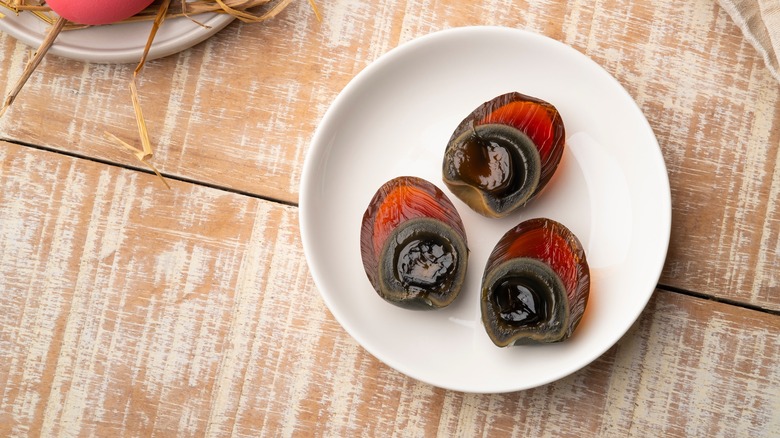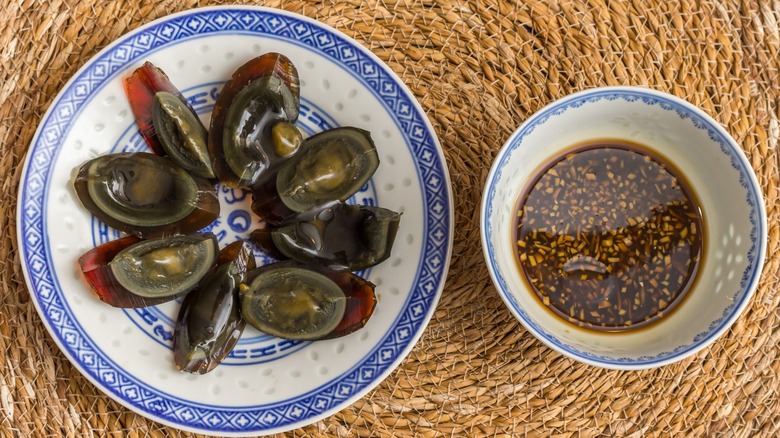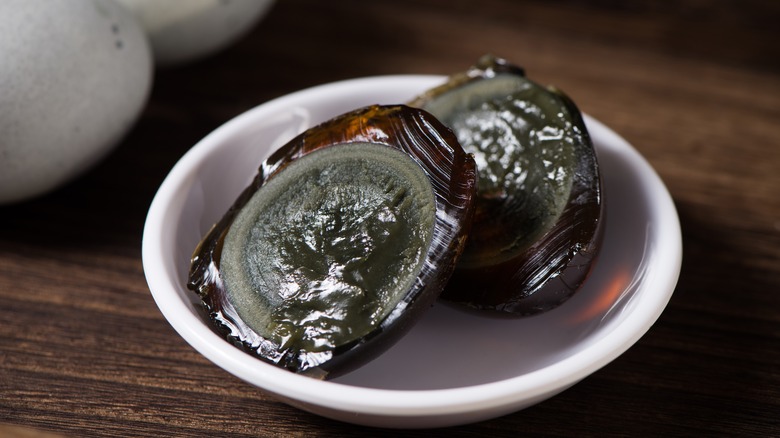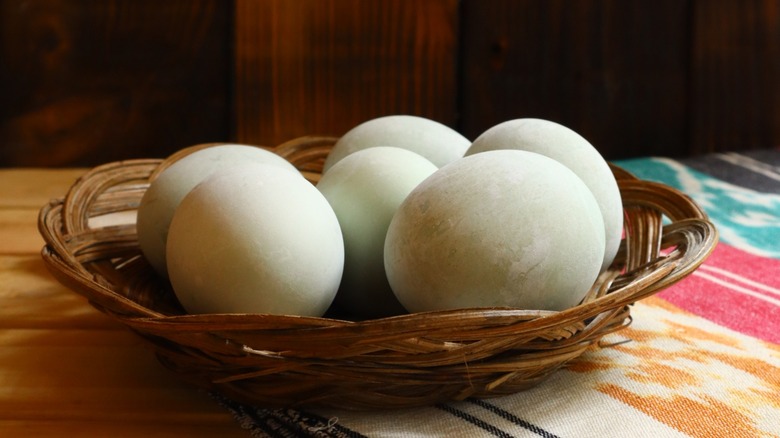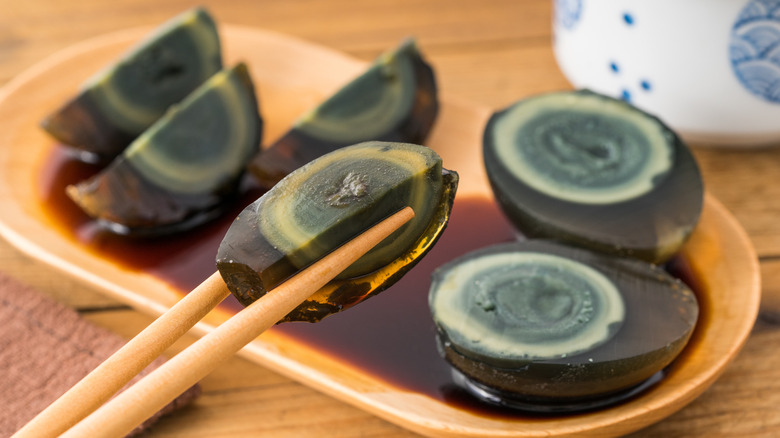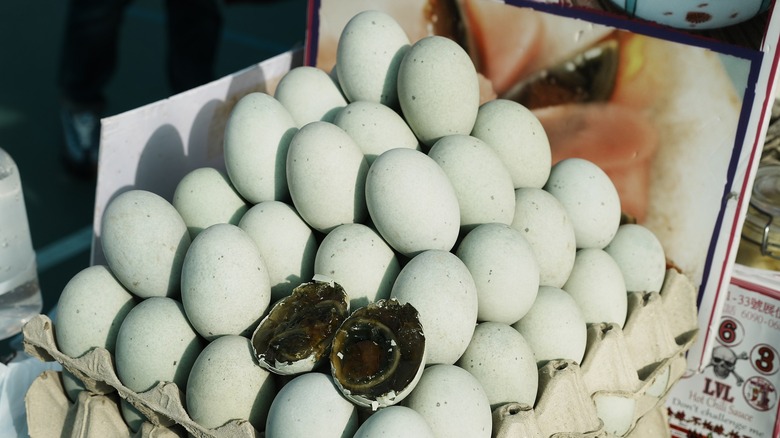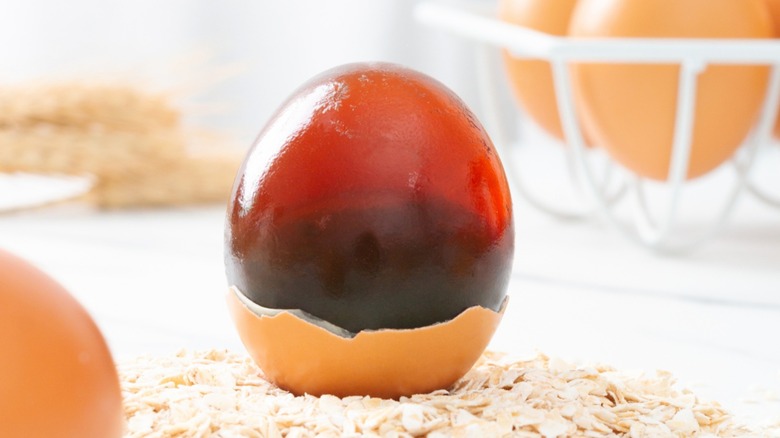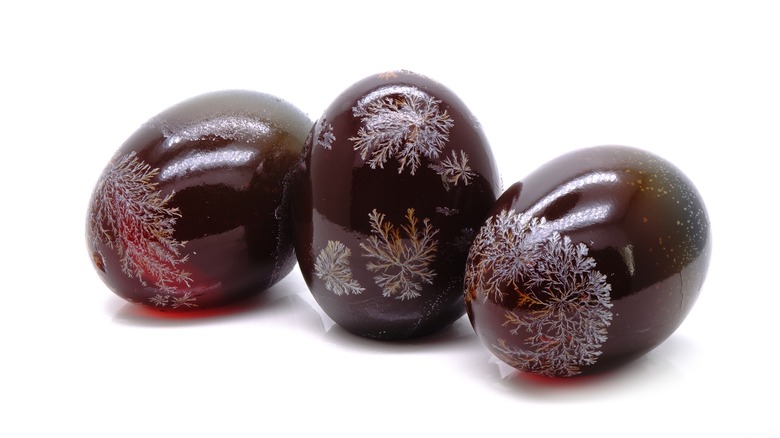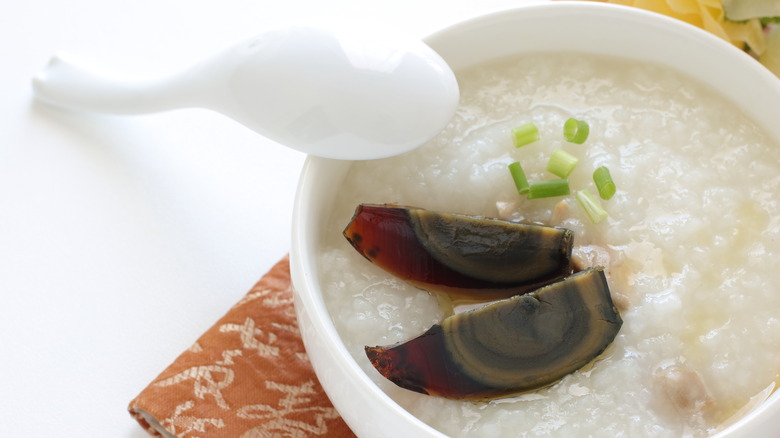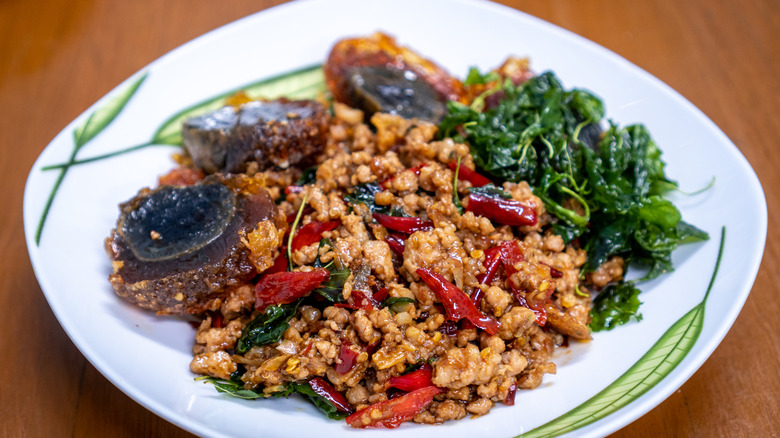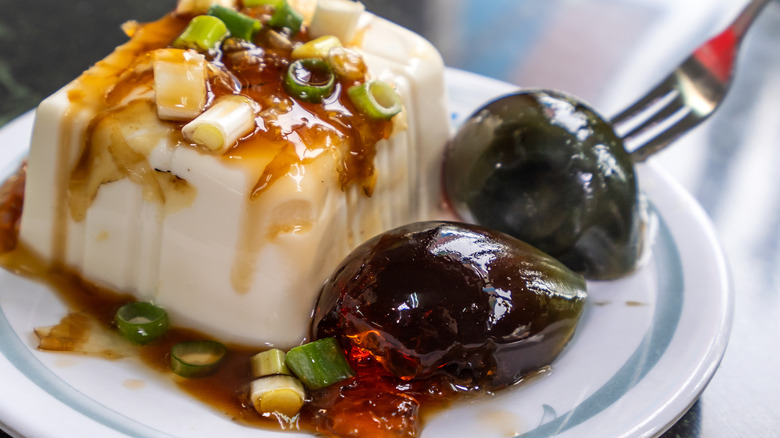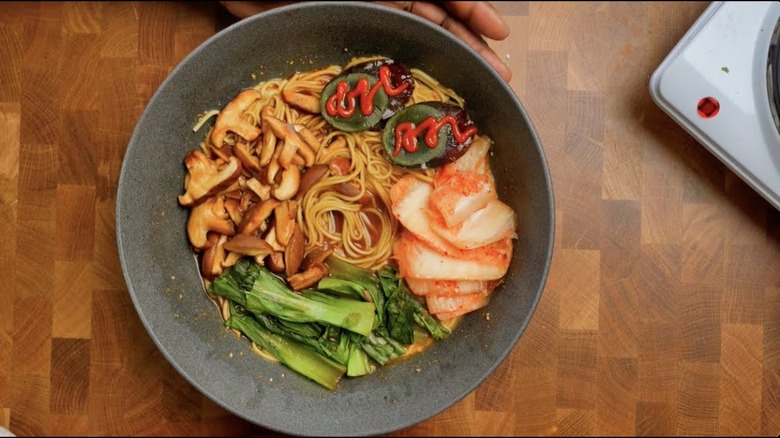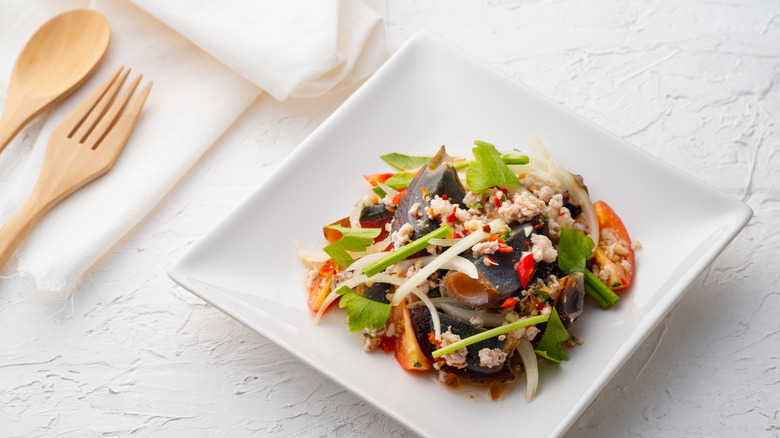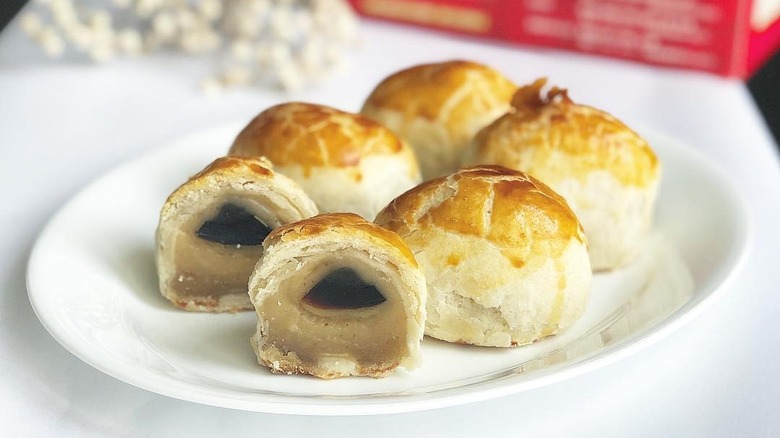A Beginner's Guide To Century Eggs
Century eggs are a well-known food in East and Southeast Asia, but tend to be approached with a little trepidation by Western foodies who may have often heard them misleadingly described as "rotten." Those who're familiar with them though, very much enjoy the taste of this unusual delicacy. The unique way they're cured gives them a deep, rich, and distinctive flavor and a long shelf life. They can often be found in the fridge section of Chinese supermarkets, sometimes sold coated in clay and rice husks which can be cleaned away before eating. Just avoid any eggs with broken shells.
There's no denying that century eggs have an aroma that many find unappealing at first, but the same is true of some Western foods like gorgonzola cheese. The curing process, technically a kind of fermentation, changes both the color and texture of the eggs, turning the egg whites the deep brown color of black tea and a gelatinous consistency while giving the yolk a dark, greenish hue and a gooey texture. However, century eggs are most definitely worth trying,even if they are a little off-putting to begin with.
Best known in Chinese cuisine, where they're known as pí dàn (皮蛋), century eggs are eaten in several Asian countries, including Vietnam, Taiwan, Cambodia, and Thailand. The key to their popularity lies in their umami flavor, stronger than regular eggs. To boost the deep flavor and umami richness even further, they're usually made from duck eggs.
Five centuries of century eggs
The oldest known record of people making century eggs comes from the Ming Dynasty in medieval China, most likely originating in Hunan Province, roughly 500 years ago. They're still popular in Hunan to this day, where they're often served mashed, with sautéed chillis, garlic, and sesame oil.
The traditional curing process, still used by some modern manufacturers, is to create a mixture of black tea, lime (the caustic kind not the fruit), salt, and wood ash. This makes a thick paste in which fresh eggs are wrapped and left for around five months. The coated eggs are then wrapped in rice husk before being sold in markets. On sale, they have a coating around a ¼ inch thick, giving them an appearance a little like fossilized dinosaur eggs. It's easy to see how they earned their English name, though the Chinese name of pí dàn just translates as "preserved egg."
Like many other foods in the world, this unusual process was created as a way to preserve food in the days before household refrigerators. The result is that century eggs have an extremely long shelf life, for as long as the shells remain unbroken. They don't even need to be kept in the fridge, though this increases their shelf life even further. The eggs can last for months in a pantry, but can theoretically remain good to eat indefinitely if they're kept chilled — though they probably won't last for an actual century.
How century eggs are made
Some century eggs today are still made using the original method, with a mixture of lime, salt, ash, and black tea. While the traditional recipe calls for them to be left for a full five months to prepare, many modern-century eggs use different curing methods, making them ready to eat in just seven weeks. They're often prepared by immersing them in a vat of caustic tea and lime, and leaving the alkaline chemicals to slowly do their work.
The strongly alkaline mixture is essential to coagulate the egg proteins. The technical name for the process is alkaline fermentation, though this is a bit of a misnomer. While most fermentation uses things like yeast or lactic acid bacteria, the process for making century eggs is pure chemistry, keeping all bacteria out. In some ways, it's very similar to cooking — the egg whites of century eggs turn brown because of the Maillard reaction, a food chemistry process that also makes things like toast turn brown as they cook. Much slower, this process starts to break down the egg proteins too, splitting them apart at a molecular level. This is what gives the finished century eggs a completely different flavor.
The process also sometimes leaves salt crystals behind on the egg, in a branching pattern. They have a similar appearance to the frost feathers which can sometimes form on windows overnight in winter. This pattern sometimes gives them the name of "pine flower" eggs.
Making your own century eggs
It's not too difficult to find century eggs on sale anywhere Chinese groceries are available, but there are lots of people who don't have access to places that sell them. The alternative is simply to make your own, and some may want to try this even if they have somewhere to buy them from. For anyone who enjoys making their own fermented foods, it's possible to make your own century eggs at home. For the adventurous, it's a process a bit like homebrewed alcohol or homemade pickles, taking some time and patience to properly complete.
To start the process you'll most likely be using black tea, kosher salt, and food-grade lye or sodium hydroxide. Be careful with the mixture though, and be sure to use gloves — it's as caustic as a household bleach solution. The whole process takes a couple of months, after which you'll have a set of homemade century eggs ready to enjoy. Another benefit of making your own is that you can use whatever egg you prefer. Any type can theoretically work, so you could try making some century quail eggs, for a more bite-sized option, or even try using goose eggs for something a bit larger than normal.
What are century eggs like to eat?
Century eggs are certainly something of an acquired taste, especially when put side-by-side with regular eggs. The curing process changes the eggs dramatically, both in texture and color, and some people find the greenish shade of the yolks a bit unappealing. The whites have a gelatinous texture, and the yolks remain quite creamy, with a texture some people compare to brie. They also have a strong aroma with a hint of ammonia, which some people may find off-putting at first.
To those who take time to get used to century eggs, the smooth texture and rich flavor are things that many people find extremely enjoyable. Because the egg is made through an alkaline process, some like to pair it with sharp, acidic flavors, and a popular choice in some parts of China is pickled ginger. Century eggs are sometimes served this way as an appetizer before a large meal.
Chefs popularly compare century eggs to blue cheese. The flavor isn't for everyone, but it's much better than the unusual appearance may suggest. For those who have difficulty getting used to the flavor, some advise steaming them first, which reportedly gives them a milder taste, as well as a firmer yolk. Cooking is unnecessary though, as century eggs are ready to eat as soon as they're removed from the shell. Gourmets say that the taste pairs well with wines like Bordeaux or Champagne.
Myths about century eggs
There are a few rather unpleasant myths around century eggs that are worth dispelling. For a start, despite the name, they aren't a century old, though they can be cured for many months before being served. Century eggs can easily last for a year before being eaten. Importantly, despite how they're sometimes described, century eggs are not rotten. This word is often used to describe them, even by reputable outlets like newspapers and magazines, but century eggs don't taste or smell rotten. Made properly, the eggs are completely free of any mold or bacteria. Being made in a process too caustic for bacteria to survive, they're completely hygienic and safe to eat.
Another persistent myth about century eggs that some people may have heard is that they're made with horse urine, but this isn't true either. This idea likely came from a misunderstanding in translation. In Thailand, one rather unfortunate name for century eggs is "horse urine eggs," but this has nothing to do with how they're made. Instead, it refers to the slight scent of ammonia that century eggs often have.
Cautions about century eggs
As with any other egg, it's best to avoid any century eggs with damaged shells. While they have a long shelf life, the moment the shell is broken, the eggs will spoil like any other food. Some Chinese restaurants prepare their own, priding themselves on making their eggs using the slow, traditional ways that have been used in China for centuries. Foodies often prefer places like these, offering a more authentic experience, and it's certainly true that the old-fashioned methods often give a better flavor. There is, however, another more serious reason to choose these over cheaper century eggs you may find elsewhere.
In 2013, per the South China Morning Post, several companies in China were shut down for using toxic chemicals to speed up the curing process of their century eggs. Faster curing means faster production, which in turn means that a factory can make more profits. To speed up the process, some factories in Nanchang county were using industrial copper sulfate to cut the curing process down to just one month. As well as being toxic itself, industrial copper sulfate can also include poisonous heavy metals like lead and cadmium. To be on the safe side, it's best to pay a little extra for properly made century eggs, to be certain they were properly handled. For first-timers, traditionally made eggs are probably the best introduction anyway.
Nutritional value of century eggs
Eggs in general have occasionally been controversial in the past, with some outdated claims that they contain unhealthy levels of cholesterol. Newer studies have found that not only was this a false alarm, but eggs are essentially a perfect food, containing virtually all the essential nutrients your body needs. The same is true of century eggs, which can make for a densely nutritious addition to any meal.
Compared with regular eggs, the curing process of century eggs leaves them with a higher percentage of protein and fewer carbohydrates. They're also a good source of some minerals, particularly iron, and selenium, and are richer in amino acids than regular eggs. Century eggs are an excellent source of dietary lysine. There's one big thing to be wary of with these eggs, however. Simply, they're made with a lot of salt, so they contain a lot of sodium. A single century egg can contain as much as 400 mg of sodium, which is almost ⅕ of the recommended daily allowance. Anyone with high blood pressure should probably be cautious about trying this particular delicacy.
Century egg congee
In China, probably the most popular way to eat century eggs is in congee. A kind of savory rice porridge, congee is made by boiling rice until the grains fall apart, and can include all kinds of ingredients according to personal tastes. A classic Chinese comfort food, congee fills a similar cultural niche to things like chicken soup in the Western world, being a warming, soothing meal on cold days. Boiled eggs are a popular addition to it, and century eggs work just as well.
For wholesome dishes like congee, the trick is to prepare a dish with a rich umami flavor, which is why the basic recipe uses chicken or vegetable stock instead of plain water. The extra umami kick century eggs can give makes them an ideal addition. As well as adding richness, the strong flavor of the eggs goes nicely with the milder flavor of the rice. Century eggs are often added to congee made with pork, though it tastes just as good with chicken. Some people like to add chopped century eggs into the cooking pot a few minutes before the dish is ready to be served, giving them time to infuse some flavor into the congee but not leaving them in for so long that they start to completely fall apart.
Century egg stir-fry
The light, sharp flavors of a good stir fry can go excellently with the richer base flavors of century eggs. Popular with minced pork, the century eggs can simply be sliced into quarters and added to the pan for the last few minutes of cooking. Before frying, some people like to briefly boil the century eggs, to give them a slightly firmer texture and help them hold their shape. As well as in Chinese cuisine, this works well in Thai cooking. A classic home-cooked Thai dish is pad kra pow, a stir-fry that's usually made with ground meat, seasoned with bird-eye chilis and the aromatic aniseed-like flavor of Thai basil. This dish can be made with all kinds of ingredients, and while not exactly a typical addition, sliced century eggs can go very nicely in it.
You can also try mixing and matching your eggs. Another type of preserved egg in Chinese cuisine is the salted duck egg, made by leaving duck eggs to soak in brine, and these can be sliced into pieces and fried together with century eggs. The resulting stir-fry dish gives some color variation, with the two types of eggs side by side.
Century eggs with tofu
In Taiwan, if you see century eggs on the menu, they're very likely to be served with tofu. A cold dish, good to enjoy for brunch on a hot day, this is made with silken tofu. The soft textures of the tofu and century eggs complement each other nicely, and both can be kept chilled. The only cooking required is for the all-important sauce. With a base of soy sauce, it's usually made with a mixture of flavorsome ingredients like ginger, garlic, sesame oil, mirin wine, red chili, and spring onions. The result is a careful balance of flavors, with the alkaline taste of the egg balanced by the sharper tang of the sauce, while the mild tofu helps to stop the stronger flavors from being overpowering.
The mild taste of tofu is a popular pairing with century eggs in China too. An everyday dish, which doesn't need any cooking, is to dice tofu and century eggs and serve them as a salad. A much milder dish with a less complex combination of flavors, it's seasoned with a little soy sauce, sesame oil, and a sprinkle of finely chopped spring onion.
Century egg noodles
Plenty of noodle dishes from across East Asia include boiled eggs, and they can often work just as well with century eggs. One thing to try is to make a dish of strained noodles, mixed with ingredients like spring onions and sliced chilli. If the chopped eggs are stirred into the noodles before serving, they'll start to fall apart, with the soft yolks blending into whatever sauce you serve the noodles with, giving a particularly rich and flavorful base. An elaborate noodle dish is unnecessary though, and century eggs work surprisingly well with something simple and easy like a packet of instant soup noodles.
While century eggs aren't common in Japanese cuisine, they can work very well in Japanese noodle dishes too. Ramen bowls are one of the most popular meals in Japan, with a choice of extra ingredients added into the bowl before serving. A favorite addition to a ramen bowl is a boiled egg, sliced in half, and a century egg can make for an interesting variation on a classic Japanese meal.
Century egg salad
With their jelly-like translucent appearance, century eggs can make an attractive addition to a salad. Because they're ready to eat and don't need to be cooked, this can make a century egg salad quite quick and easy to prepare, while still being filling and wholesome. As with Taiwanese-style dishes, century egg salads can work nicely with sharp flavors like ginger and garlic and the spicy bite of things like red chilli or Sichuan pepper.
Century egg salads are often prepared by cutting the eggs into wedges and arranging them in a circle, like the petals of a flower, with other ingredients in the center of the plate. Century egg salads are usually made with aromatic fresh herbs and spices, like cilantro and garlic, but they can easily work well with Western-style salad ingredients too, following the same rules. Sharp flavors like lemon juice and peppery arugula leaves, perhaps with a deeply flavored honey mustard dressing, could go just as nicely with the taste of century eggs.
Century egg pastries
Chinese cuisine contains a whole galaxy of small pastries. They're usually made with a flaky oil-based crust and filled with a combination of sweet and savory flavors with thick, heavy fillings like mung bean or red bean paste. Quite densely flavored, these go very nicely with the light, astringent taste of a cup of good green tea. While it may seem strange to Western palates, salted egg yolks are a popular ingredient in some Chinese dessert pastries. Perhaps the best example is in Chinese moon cakes, a pastry served during the Chinese Mid-Autumn Festival which is often filled with sweet lotus seed paste and a salted egg yolk, symbolizing the moon.
The idea of putting century eggs into sweet dishes is often seen as an unusual one even in China, but it's an idea that some people have recently begun experimenting with. Century egg pastries also include lotus seed paste, sometimes with sweetened pickled ginger. The bright, floral tastes of the ingredients work together with the deep, richness of the century egg, giving a surprisingly good blend of flavors. Clearly, even some of the most seemingly outlandish flavor combinations can work very well together.
